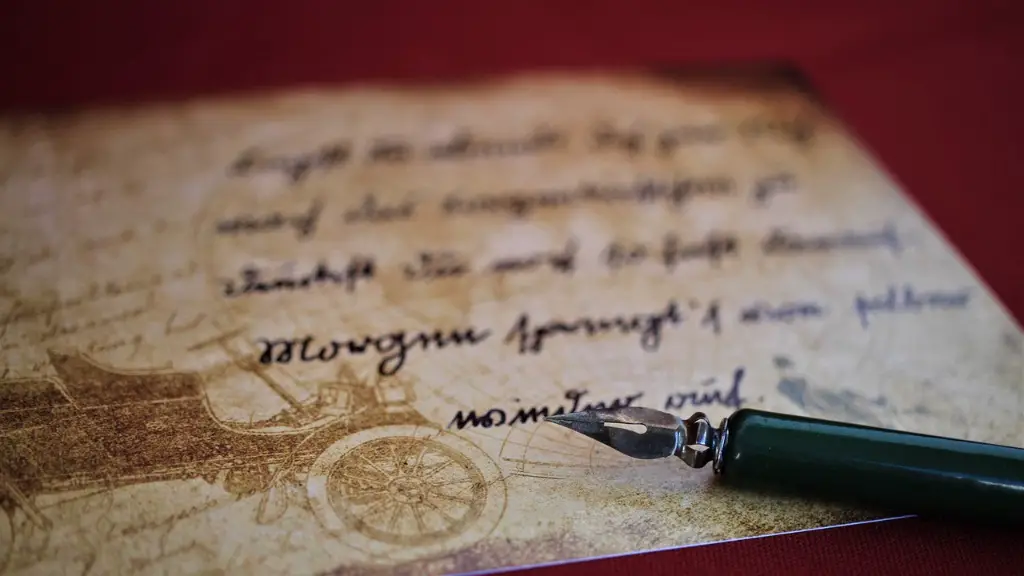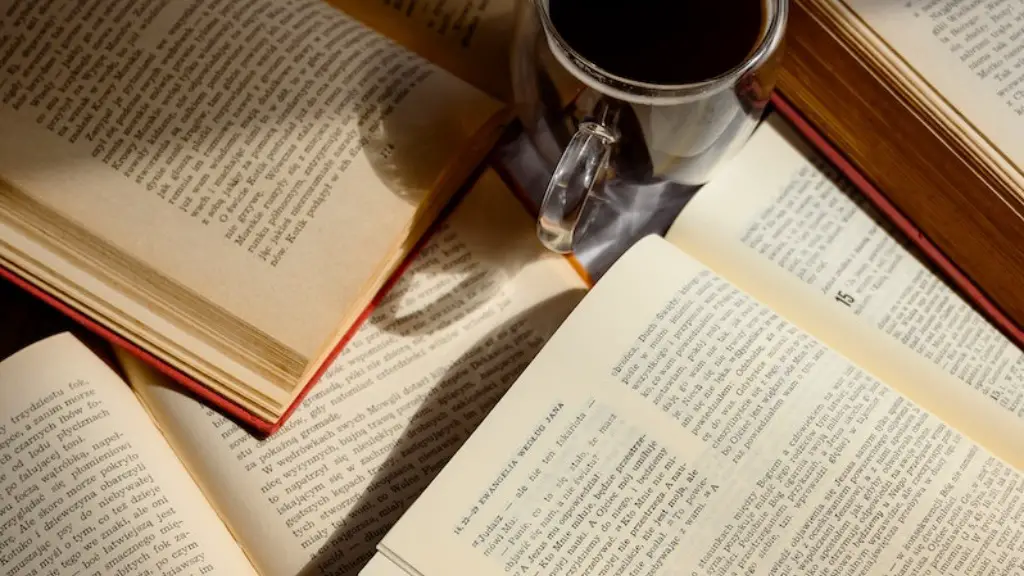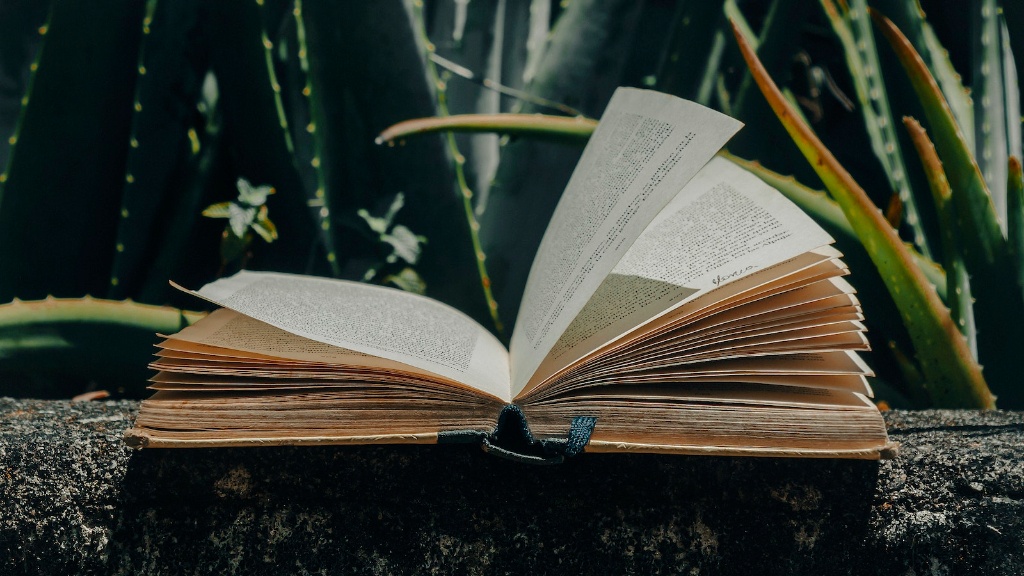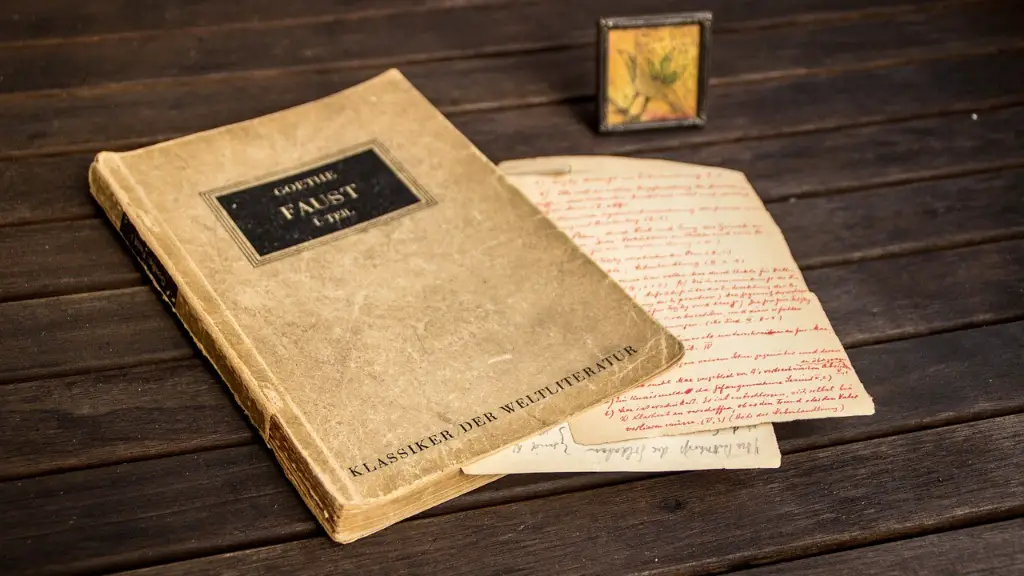What is Pentameter in Poetry
Pentameter, derived from the Greek word for “five (pente)”, is a poetic rhythm consisting of five stressed syllables per line. It is the most common meter used in poetry and is often used to create a strong, graceful and dignified rhythm. Pentameter appears in many forms of poetry, including the sonnet, ode and ballad. As pentameter is repeated throughout a poem, it creates a lyrical, almost musical, effect.
In classical poetry, pentameter was usually written in dactylic hexameter, which is composed of two dactyls and two spondees. A dactyl is a metrical foot consisting of three syllables, with the first syllable strongly stressed and the other two following with much weaker stress. A spondee is a metrical foot consisting of two stressed syllables. This gave an distinctive effect to classical poetry, as alternation of this pattern in each line created a slow, lyrical and relaxed rhythm.
Today, pentameter is used in poetry to create a variety of effects. It can convey a steady, repetitive rhythm that is used to emphasize ideas and bring coherence to a poem. It can also be used to create a sense of urgency and speed. For example, William Wordsworth’s “To the Cuckoo” makes use of this meter to create a sense of urgency and movement. Pentameter can also be used to emphasize particular lines or phrases in a poem.
In addition to its use in classical poetry, pentameter is often used in modern poetry and literature. In dramatization or epic poetry, it can be used to bring structure and form to a poem or to create a narrative effect. In free verse, pentameter can be used to add a sense of structure and rhythm, as well as to create moments of heightened emotion and emphasis. Many writers have even explored the use of pentameter and other metrical systems as a way of expressing their emotions and ideas. William Butler Yeats’ “The Lake Isle of Innisfree” is an example of a poem written in pentameter.
Pentameter is an important tool for any poet, as it allows them to explore the different effects of various rhythms and meters. It gives them freedom to experiment and create new, exciting styles. The use of pentameter allows a poet to create a unique and interesting pattern within their work that can add an additional layer of meaning to their work, as well as making it easier to understand.
Pentameter and Dramatic Effect
As mentioned above, pentameter can be used to create a strong and powerful effect. The use of pentameter can help to emphasize a character’s emotions and drive the plot in a provocative and exciting way. For example, in William Shakespeare’s “Macbeth”, he uses the meter to create a dramatically intense effect and to convey the range of emotions experienced by the characters. The use of pentameter in conjunction with other elements of drama, such as pacing and dialogue, can help to bring a heightened sense of emotion to a play, poem, or even a novel.
In addition to its use as a dramatic tool, pentameter can also be used to convey a sense of elegance and refinement. The graceful rhythm of pentameter can be used to create an atmosphere of beauty and delicacy. For example, in Andrew Marvell’s “To His Coy Mistress”, the graceful lines and intricate detail add a sense of delight and mystery to the piece.
Pentameter also has a place in more contemporary forms of poetry. In spoken word and rap, it is often used to create a strong beat, and to emphasize particular words or phrases. The rhythm of pentameter can be used to create a powerful atmosphere and to give an edge to the piece. Many modern poets have explored the use of pentameter to create exciting and unique styles of poetry.
Pentameter and Emotion
Pentameter can also be used to convey a range of emotions. The use of rhythmic patterns can be used to convey feelings of joy, sorrow, love, and longing. For example, William Wordsworth’s “Tintern Abbey” uses the meter to bring a sense of melancholy to the poem, as well as a sense of beauty and peace. Similarly, the rhythmic patterns of Edgar Allen Poe’s poem “Annabel Lee” conveys a sense of sadness and longing.
The use of pentameter can also be used to create a sense of momentum and excitement. It can be used to create a feeling of energy and dynamism. This can be used to add an additional layer of emotion to a poem or play. In “Romeo and Juliet”, for example, the use of pentameter adds a sense of urgency and passion to the piece, as well as giving the characters a sense of movement and life.
In conclusion, pentameter is an important tool for any poet or dramatist. It can be used to create a wide range of effects, from creating a sense of dread and fear, to conveying a sense of momentum and excitement. It can also be used to bring a sense of elegance and refinement to a poem or play. The use of pentameter can add a new dimension of emotion and intensity to a piece, as well as providing structure and form.
Pentameter and Rhythm
In addition to its use as a dramatic tool, the use of pentameter can also be used to create a particular rhythm or melody. This can be used to add an additional sense of emotion or intensity to a poem or play. In William Shakespeare’s “Romeo and Juliet”, for example, the use of a particular metrical pattern gives the lines a rhythm and energy that brings life to the characters and story.
Pentameter can also be used to bring a sense of structure to a poem. The use of a regular, repeated rhythm can be used to create a sense of coherence, as well as providing a sense of control over the piece. For example, in Percy Bysshe Shelley’s “Ode to the West Wind”, the consistent pattern of pentameter gives the poem a sense of order and unity.
The use of pentameter can also bring a sense of intensity to a poem. The repetition of certain words or phrases can draw the reader’s attention to the ideas expressed. This can give a heightened sense of emotion or intensity to a piece. For example, in John Milton’s “Paradise Lost”, pentameter is used to create a powerful and emotive effect, as the repeated words draw the reader into the narrative.
Pentameter and Musicality
The use of pentameter can also bring a sense of music to a poem or play. By using a particular rhythm or pattern of rhymes, a poet can add an additional layer of emotion or intensity to a piece. For example, in John Donne’s “Death be Not Proud”, the use of a slow and steady rhyme scheme brings a sense of rhythm and music to the poem. Similarly, in William Wordsworth’s “The World is Too Much with Us”, the use of pentameter creates a lyrical effect, as well as adding to the overall effect of the poem.
Pentameter can also be used to emphasize particular lines or phrases. This can add an additional layer of emotive force to a piece. For example, in Alfred, Lord Tennyson’s “Ulysses”, the use of the meter emphasizes the repeated words and phrases, which adds a sense of longing and urgency to the poem. Similarly, in Robert Frost’s “Stopping by Woods on a Snowy Evening”, pentameter is used to emphasize certain lines and words, as well as giving a sense of power and movement to the poem.
In conclusion, pentameter is an essential tool for any poet or writer. It can be used to create a wide range of effects, from creating a sense of dread and fear, to conveying a sense of excitement and joy. It can also be used to create a sense of unity, or to emphasize certain words or phrases. The use of pentameter can add a new dimension of emotion and intensity to any poet’s work, as well as providing structure and form.
Pentameter in Modern Poetry
Although pentameter is traditionally associated with classical poetry, it has a place in modern poetry as well. Modern poets have explored the use of pentameter as a way of expressing themselves, as well as to bring form and structure to their work. For example, T.S. Eliot’s “The Love Song of J. Alfred Prufrock” makes use of a pentameter in order to create a sophisticated and complex effect. Similarly, in Robert Frost’s “The Road Not Taken”, pentameter is used to bring life and emotion to the poem.
Modern poets have also explored the use of pentameter to create a sense of urgency and speed. For example, Nikki Giovanni’s “Ego Tripping” makes use of the meter to convey a sense of urgency and excitement, as well as adding to the overall effect of the poem. Similarly, in the poem “Harlem” by Langston Hughes, pentameter is used to emphasize certain lines and words, as well as giving the poem a sense of movement and power.
In addition to its use as a tool for modern poets, pentameter can also be used to emphasize particular lines or phrases. By using a particular rhythm or pattern of rhymes, a poet can draw the reader’s attention to the ideas expressed. This can give an added layer of emotion or intensity to a poem. For example, in Sylvia Plath’s “Daddy”, the use of pentameter emphasizes the repeated phrases, which adds a sense of intensity and energy to the piece.
In conclusion, pentameter is an important tool for any poet or writer. It can be used in a variety of ways, to create a wide range of effects, from creating a sense of dread and fear, to conveying a sense of momentum and excitement. The use of pentameter can also add an additional layer of emotion or intensity to a poem, as well as providing structure and form.
Pentameter and Expression
Pentameter can also be used as a tool for personal expression. By using a particular rhythm or pattern of rhymes, a poet can communicate their feelings and ideas to the reader. This can bring a heightened sense of emotion or intensity to a poem. For example, in W.B. Yeats’ “The Wild Swans at Coole”, the use of a particular rhyme scheme brings a sense of sorrow and longing to the poem. Similarly, in Seamus Heaney’s “Blackberry picking”, pentameter is used to emphasize particular words and lines, as well as conveying a sense of joy and nostalgia.
Pentameter can also be used to create a sense of movement in a poem. The steady rhythm of pentameter can create a sense of energy and dynamism. This can be used to bring a sense of life and urgency to a piece. For example, in William Blake’s “The Tyger”, the use of pentameter creates a sense of power and movement, as well as bringing a heightened intensity to the poem.
The use of pentameter can also be used to create a sense of beauty and grace. By using a particular rhythm or pattern of rhymes, a poet can create an atmosphere of delicacy and beauty. This can add an additional layer of





